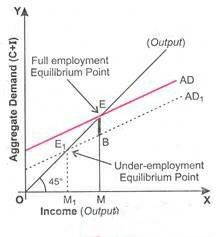Difference between Full Employment and Under-Employment Equilibrium
(i) Full Employment Equilibrium:
When equilibrium between AD and AS takes place at full employment of resources, it is called full employment equilibrium. There are no unused resources. There is no involuntary unemployment.
When equilibrium between AD and AS takes place at full employment of resources, it is called full employment equilibrium. There are no unused resources. There is no involuntary unemployment.
The situation of full employment equilibrium has been illustrated in Fig. AS is expressed by 45° line whereas the line AD represents aggregate demand
(ii) Under-employment equilibrium:
Under-employment equilibrium means equality between aggregate demand and ‘aggregate supply but at less than full employment’. In other words, in producing the output, economy’s some resources are underemployed.
OM1 is the under-employment equilibrium level of income which is less than OM full employment equilibrium level of income. Under-employment equilibrium gives rise to deflationary gap shown as EB in the Fig.
OM1 is the under-employment equilibrium level of income which is less than OM full employment equilibrium level of income. Under-employment equilibrium gives rise to deflationary gap shown as EB in the Fig.
Additional investment expenditure equal to the level of EB (i.e., deflationary gap) is required to reach full employment equilibrium.
